Click on images to enlarge

dense infestation (Photo: Sheldon Navie)
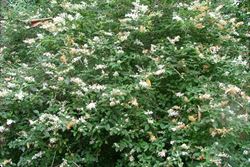
habit in flower (Photo: Sheldon Navie)

habit in fruit (Photo: Sheldon Navie)

multi-branched trunks (Photo: Sheldon Navie)

younger branches with paired leaves (Photo: Sheldon Navie)
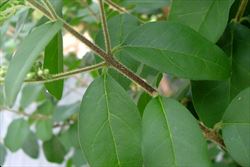
close-up of hairs on younger stem and leaves (Photo: Sheldon Navie)

flower clusters (Photo: Sheldon Navie)
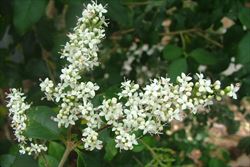
flower cluster (Photo: Sheldon Navie)
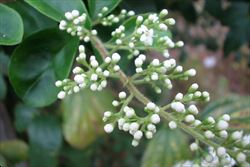
close-up of flower buds (Photo: Sheldon Navie)
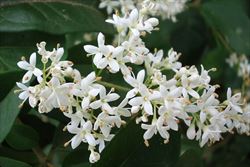
close-up of flowers (Photo: Sheldon Navie)

immature fruit (Photo: Sheldon Navie)

mature fruit (Photo: Sheldon Navie)
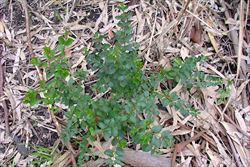
root sucker (Photo: Sheldon Navie)
Scientific Name
Ligustrum sinense Lour.
Synonyms
Ligustrum villosum May
Family
Oleaceae
Common Names
Chinese liguster, Chinese ligustrum, Chinese privet, hedge privet, ligustrum, narrow-leaf privet, narrowleaf privet, privet, small leaved privet, small-leaf privet, smallleaf privet, small-leaved privet
Origin
Native to China and south-eastern Asia (i.e. Taiwan, Laos and Vietnam).
Cultivation
Chinese privet (Ligustrum sinense) has been widely cultivated in eastern and southern Australia, and was particularly popular as a hedging plant in older gardens. It it still cultivated for this purpose, and some of these hedges have some heritage value. Several cultivars of this species are also cultivated, the most common of which has variegated leaves (i.e. Ligustrum sinense 'Variegatum').
Naturalised Distribution
This species is mainly naturalised in the coastal and sub-coastal districts of eastern Australia. It is most common in south-eastern Queensland and the coastal and sub-coastal regions of eastern New South Wales. Occasionally naturalised in the ACT and Victoria, and scattered in central and northern Queensland. Also recorded as naturalised on Lord Howe Island and Norfolk Island.
Also naturalised in southern Africa, Argentina, New Zealand, on several Pacific Islands (e.g. Hawaii, Fiji, Guam, Tonga, American Samoa and Western Samoa) and in the southern and eastern parts of the USA.
Habitat
Chinese privet (Ligustrum sinense) is most commonly found in wetter tropical, sub-tropical and temperate regions. It is a particularly common weed of rainforest areas and waterways, but is also a weed of urban bushland, gullies, open woodlands, waste areas, disturbed sites and roadsides.
Habit
A large shrub or a small tree usually growing less than 3 m tall, but occasionally reaching 4-5 m in height.
Distinguishing Features
- a shrub or small tree with hairy younger stems and leaves.
- its relatively small leaves (2-7 cm long and 1-3 cm wide) are borne in pairs along the stems.
- its small white flowers have four petals and are produced in small branched clusters (4-11 cm long) at the tips of the stems.
- its small rounded or egg-shaped fruit (4-6 mm long) turn bluish-black in colour when mature.
Stems and Leaves
The new growth of this plant (i.e. the younger stems and leaves) is finely hairy (i.e. pubescent). Younger stems are rounded (i.e. terete) and greenish in colour, while older stems turn greyish-brown as they mature.
The leaves are egg-shaped in outline (i.e. ovate) to oval (i.e. elliptic) in shape and are borne on short stalks (i.e. petioles) 3-8 mm long. These leaves (2-7 cm long and 1-3 cm wide) are oppositely arranged on the stems, with entire or wavy (i.e. undulate)margins. They are usually densely hairy (i.e. pubescent), particularly on their undersides, and have pointed tips (i.e. acute to acuminate apices).
Flowers and Fruit
The small flowers are white or cream in colour, with four petals (2-5.5 mm long) that are fused together at the base (i.e. into a very short corolla tube). They also have four tiny sepals (1-1.5 mm long) and two stamens. These flowers are arranged in dense, branched clusters (4-11 cm long) at the tips of the branches (i.e. in terminal panicles). Each flower is borne on a short stalk (i.e. pedicel) 1-5 mm long. Flowering occurs mostly during late winter and spring, but may sometimes continue into the summer.
The small berry-like fruit (actually drupes) are rounded (i.e. globular) or slightly egg-shaped (i.e. ovoid). These fruit (4-8 mm long) turn from green to black, bluish-black or purplish-black as they mature.
Reproduction and Dispersal
This species reproduces by seed, root suckers, and it also resprouts after its stems are deliberately cut or otherwise damaged.
Its seeds are readily dispersed by fruit-eating (i.e. frugivorous) birds and other animals. They may also be spread by water or in dumped garden waste.
Environmental Impact
Chinese privet (Ligustrum sinense) is regarded as a significant environmental weed in New South Wales and Queensland, and as an environmental weed or potential environmental weed in Victoria and the ACT. This species causes widespread and significant environmental damage, and was recently listed as a priority environmental weed in seven Natural Resource Management regions. It is of most concern in south-eastern Queensland, where it is ranked among the top 25 most invasive plant species, and in eastern New South Wales.
Chinese privet (Ligustrum sinense) commonly invades gullies, creeklines, watercourses, forest gaps and the margins of rainforests in eastern Australia, and tends to grow in more fertile soils. It forms dense thickets and its densely branching growth habit enables it to shade out other plants. It also germinates and grows relatively well in shady sites, giving it the ability to outcompete or suppress native vegetation living in the understorey of forests. Its tenacious root system also reduces the availability of water and nutrients for competing native species, and when the roots or stems are damaged or cut they sucker prolifically. Chinese privet (Ligustrum sinense) will eventually come to dominate the shrub layer of an invaded habitat, thus altering species composition and natural community structure by choking out native plant species. This transformation alters the habitat available to native animals and stands of this weed may also grow sufficiently thick to hinder animal movement through bushland areas.
Chinese privet (Ligustrum sinense) is also a major environmental weed in other parts of the world and has been listed in the Global Invasive Species Database. It displaces the shrub layer of forests and woodlands in New Zealand, Argentina and south-eastern USA and also invades river and stream floodplains, lake shores, and the edges of swamps and marshes in the USA. Its invasiveness already threatens the survival of endangered species in the USA, such as the Miccosukee gooseberry (Ribes echinellum).
Other Impacts
The leaves and fruit of this species are poisonous to livestock and humans. Chinese privet (Ligustrum sinense) also produces masses of heavily scented white flowers in spring that cause severe allergic reactions in susceptible people.
Legislation
This species is declared under legislation in the following states and territories:
- ACT: C4 - prohibited pest plant (a pest plant whose propagation and supply is prohibited).
- New South Wales: Class 4 - a locally controlled weed. The growth and spread of this species must be controlled according to the measures specified in a management plan published by the local control authority and the plant may not be sold, propagated or knowingly distributed (in a large number of local authority areas). See the New South Wales Department of Primary Industries Noxious Weeds List at http://www.dpi.nsw.gov.au for more detailed information on which local areas are covered in these declarations.
- Queensland: Class 3 - this species is primarily an environmental weed and a pest control notice may be issued for land that is, or is adjacent to, an environmentally significant area (throughout the entire state). It is also illegal to sell a declared plant or its seed in this state.
- Western Australia: Prohibited - on the prohibited species list and not permitted entry into the state.
Management
For information on the management of this species see the following resources:
- the Biosecurity Queensland Fact Sheet on this species, which is available online at http://www.dpi.qld.gov.au.
- the New South Wales Department of Primary Industries Agfact on privets, which is available online at http://www.dpi.nsw.gov.au.
Similar Species
Chinese privet (Ligustrum sinense) is very similar to broad-leaved privet (Ligustrum lucidum) and common privet (Ligustrum vulgare). It is also relatively similar to Indian hawthorn (Rhaphiolepis indica). These species can be distinguished by the following differences:
- Chinese privet (Ligustrum sinense) has somewhat hairy (i.e. pubescent) younger stems and usually grows up to 3 m tall. Its relatively small leaves (2-7 cm long) have entire margins and are usually present year-round (i.e. it is evergreen).
- broad-leaved privet (Ligustrum lucidum) has hairless (i.e. glabrous) younger stems and grows up to 12 m or more tall. Its relatively large leaves (4-24 cm long) have entire margins and are present year-round (i.e. it is evergreen).
- common privet (Ligustrum vulgare) has hairless (i.e. glabrous) or finely hairy (i.e. puberulent) younger stems and grows up to 5 m tall. Its relatively small leaves (2-6 cm long) have entire margins and are often lost during winter (i.e. it is deciduous).
- Indian hawthorn (Rhaphiolepis indica) has hairless (i.e. glabrous) or slightly hairy (i.e. puberulent) younger stems and usually grows up to 2 m tall. Its moderately-sized leaves (3-7 cm long) have coarsely toothed (i.e. serrate) margins and are usually present year-round (i.e. it is evergreen).
Chinese privet (Ligustrum sinense) may also be confused with native privet (Ligustrum australianum), which is present in northern and central Queensland. However, native privet (Ligustrum australianum ) has smaller flowers with petals only about 2 mm long. It is sometimes also confused with various native rainforest species when not in flower or fruit, including cheese tree (Glochidion ferdinandii) and many of the lilly-pilly's (Syzygium spp.).

